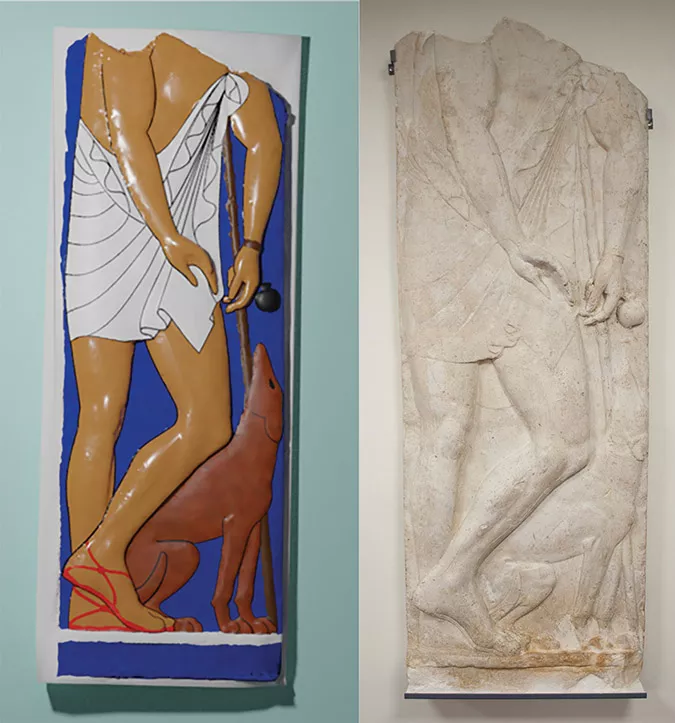Coloring the Past
Pandemic Projects
New Ways of Looking at Old Objects
Before and during the pandemic, students were able to work on a number of projects that involved fresh ways of looking at collections and resulted in new insights into the ways in which these objects were used and seen in the past. —Eric Pumroy, Seymour Adelman Director of Special Collections
Left: polychrome 3D reconstruction of the Borgia Stele by Mira Yuan. Right: plaster cast of Borgia Stele in BMC Special Collections (2016.1.1).
White marble sculpture and architecture evoke ancient Greece and Rome. Perpetuated in popular media, video games, and museums, these images are, however, false representations of the richly colorful (polychromatic) world of ancient Greece and Rome. Although white marble sculpture may be synonymous with beauty in the modern world, ancient people deemed sculpture beautiful only after it had been painted.
Archaeological and textual evidence confirm that ancient sculpture and architecture were painted in bright colors and patterns, yet these artifacts continue to be exhibited with little to no reference to their original aesthetic. This curatorial practice not only provides an incomplete reading of the meaning and impact of ancient visual arts but also reinforces false concepts of beauty and ideas of “whiteness” that have been misappropriated by radical groups such as white nationalists.
By reintroducing polychromy to the Bryn Mawr College community, an interdisciplinary project called Coloring the Past: Restoring Color to Ancient Sculpture Through Projection Mapping aims to provide a more accurate representation of ancient sculpture and create a sensory viewing experience of it. Organized by Laura Surtees, M.A.’08, Ph.D. ’12, during summer 2020, the project integrates archaeology, art history, and classics with digital scholarship. Supported by a Digital Bryn Mawr Project Grant and LITS, the Coloring the Past team brought together undergraduate and graduate students. Research and instruction librarian, coordinator of Rhys Carpenter Library, and archaeologist, Surtees led the research component, and classics graduate student Molly Kuchler trained Mira Yuan ’21 (archaeology major and museum studies minor) and Vimbai Mawoneke ’21 (math and chemistry double-major) in the technical skills and programs (Blender and photogrammetry).
For the colorized reconstructions, the team chose two plaster casts from Special Collections currently on display in the Digital Media and Collaboration Lab in Carpenter Library. Creating plaster casts of ancient sculpture was common practice in the late 19th and early 20th centuries; BMC’s plaster casts were used as teaching aids. The team reconstructed a possible color palette on plaster casts of the Borgia Stele and Nike adjusting her sandal (“Sandalbinder”) from the Temple of Athena Nike in Athens. Through comparanda and extensive research on ancient polychromy and pigments, Yuan and Mawoneke created hypothetical colorful 3D reconstructions of these casts.
COVID-19 stalled the project’s final stage—a projection mapping—although it has now been installed and will be exhibited through fall 2021. Projection mapping uses the physical object as a canvas for displaying images or videos, thereby showcasing in full scale what these reliefs might have looked like in antiquity before the pigments were washed away.
By habituating people with images of polychrome sculptures, the team hopes to create a more inclusive space in the library and contribute to ongoing conversations about diversity by painting the ancient world as a colorful place.
Published on: 07/02/2021
